Casa Sollievo della Sofferenza
HOME FOR THE RELIEF OF SUFFERING
The Hospital of Padre Pio
| 1916 |
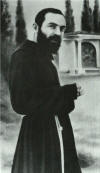  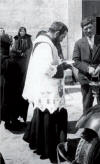 
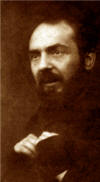 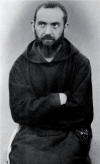  Since coming to the convent in 1916 Padre Pio wanted a hospital in San Giovanni
Rotondo. The convent was surrounded by poverty stricken sick people, in a
depressed area of the deep South of Italy, were tuberculosis, pellagra, typhoid
fever, smallpox, septicemia, meningitis, infantile paralysis, Spanish flu where endemic,
and the access to health care was primitive and unaffordable.[1]
[2] Since coming to the convent in 1916 Padre Pio wanted a hospital in San Giovanni
Rotondo. The convent was surrounded by poverty stricken sick people, in a
depressed area of the deep South of Italy, were tuberculosis, pellagra, typhoid
fever, smallpox, septicemia, meningitis, infantile paralysis, Spanish flu where endemic,
and the access to health care was primitive and unaffordable.[1]
[2]
[1] Gal95, 137-8 [2] Tan96, 169 |
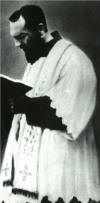

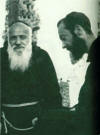

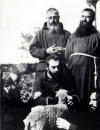
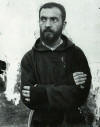

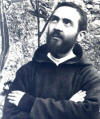



Pictures of a young Padre Pio in the first few years in the convent of St. Mary of Graces in San Giovanni Rotondo. |
|
|
Civilian Hospital St. Francis |
|
| 1925 |
On April 23, 1925 the local Congregation of Charity, with the financial support of
the alms received by Padre Pio, and the backing of Padre Ignazio da Jelsi, Guardian of the Capuchin
convent, opened a Civilian Hospital called the Hospital of Saint Francis,
downtown San Giovanni Rotondo, in a
section of the former convent of the Clares.
It had 20 beds. Two large rooms had 8 beds each for male and female patients. 2
smaller rooms had 2 beds each.
The Capuchin friars took care of the spiritual needs.
Nursing was provided by the sisters Adorers of the Sacred Heart, and later by
the sisters of the Very Precious Blood. The girls of the Franciscan trade school
provided the cleaning of the linen.
Medical director was dr. Francescantonio Giuva; vice was dr.Angelo Merla.
The surgeon dr. Bucci came twice a week from Foggia for the more difficult
surgeries. The hospital was active for 12 years.
The building was irreparably damaged by the earthquakes of July and December
1937. It was permanently closed also because of financial difficulties.
The souvenir plaque on the outside remembers the events.[3]
[4]
[3] Gia12, 313-4
[4] Pre00,55
|

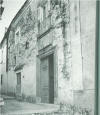 The entrance to St. Francis Hospital, downtown San Giovanni Rotondo.
The entrance to St. Francis Hospital, downtown San Giovanni Rotondo.
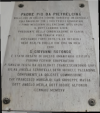 The sign commemorating the opening in 1925
The sign commemorating the opening in 1925
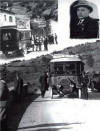 The Giuva buses.
The Giuva buses. |
|
A
brand new hospital |
|
| 1935 |
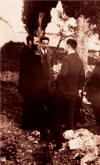 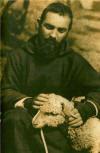
One day Padre Pio was in the square outside the church and some people
approached him. Pointing at the mountain he said: “A great hospital will be
built here.” “But there is a mountain here” he was told. Padre Pio replied: “And
we shall level the mountain.”[5]
A tiny little lady approached Padre Pio and offered him a 50 cents coin saying:
“This is for the hospital.” Padre Pio: “Keep it; you need it,” The lady: “You’re
right, it’s too little!” Padre Pio understood that the woman felt humiliated,
and said: “Give it to me, and God bless you.” Padre Pio started crying, and
every time he reported the episode he showed the coin that he had kept, and
there were always tears in his eyes.[6]
[5] Pre99, 156
[6] Chi99, 250 |
|
The first meeting |
|

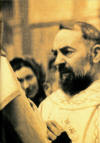
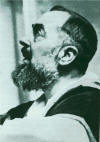
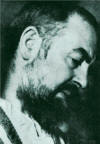
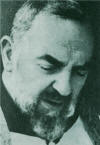

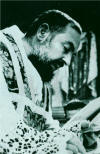
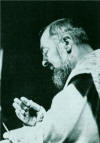
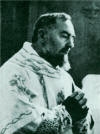
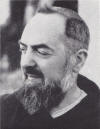
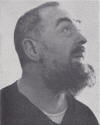 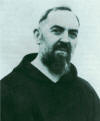
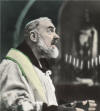







Pictures of a middle aged Padre Pio in between the St. Francis Hospital and Casa Sollievo della Sofferenza. |
|
| 1940 |
 Towards the end of 1939 Padre Pio expressed to dr. Sanvico
the
idea of building a hospital near the convent. Towards the end of 1939 Padre Pio expressed to dr. Sanvico
the
idea of building a hospital near the convent.In this cottage close to the convent lived the Sanvico and Sanguinetti families. Here was held the first meeting. |
|
|
|
 Dr. Sanvico was a veterinarian from Perugia. He was also a businessman
agronomist with the passion to make beer and had started his own brewing company
that he sold when he moved to San Giovanni Rotondo.[8]
Padre Pio told him: “I want you here, I need you”.[9] Dr. Sanvico was a veterinarian from Perugia. He was also a businessman
agronomist with the passion to make beer and had started his own brewing company
that he sold when he moved to San Giovanni Rotondo.[8]
Padre Pio told him: “I want you here, I need you”.[9]
[8] Gia12, 315
[9] All00, 507 |
|
   Dr. Guglielmo Sanguinetti from Parma. Was a country doctor in Ronta di Borgo San
Lorenzo in Mugello area, in Tuscany near Florence. In Borgo San Lorenzo he was
member of the Confraternity of Misericord. He married Emilia Spilman, his high
school sweetheart at the Liceo Tasso in Rome. Sanguinetti visited Padre Pio on
June28, 1935. He told him: “You have to come here to help me to build a large
hospital. Sell what you have and come to live here.” Sanguinetti: “I am a
country doctor, I don’t have savings, I can’t afford the move.” Padre Pio: “You
have a piece of paper that will soon solve your problems.” Back in Borgo San
Lorenzo Sanguinetti kept ruminating what Padre Pio had told him and couldn’t
find any sense. One day he finally understood what piece of paper Padre Pio was
talking about. It was a lottery ticket he had bought some time ago.
He won a large sum of money and was able
to afford the move to San Giovanni Rotondo.[10][11] Dr. Guglielmo Sanguinetti from Parma. Was a country doctor in Ronta di Borgo San
Lorenzo in Mugello area, in Tuscany near Florence. In Borgo San Lorenzo he was
member of the Confraternity of Misericord. He married Emilia Spilman, his high
school sweetheart at the Liceo Tasso in Rome. Sanguinetti visited Padre Pio on
June28, 1935. He told him: “You have to come here to help me to build a large
hospital. Sell what you have and come to live here.” Sanguinetti: “I am a
country doctor, I don’t have savings, I can’t afford the move.” Padre Pio: “You
have a piece of paper that will soon solve your problems.” Back in Borgo San
Lorenzo Sanguinetti kept ruminating what Padre Pio had told him and couldn’t
find any sense. One day he finally understood what piece of paper Padre Pio was
talking about. It was a lottery ticket he had bought some time ago.
He won a large sum of money and was able
to afford the move to San Giovanni Rotondo.[10][11] |
|
 
Dr. Carlo Kisvarday was
a
pharmacist from Zara in the north eastern corner of Italy. Zara now is called
Zadar and belongs to the State of Croatia.When he and his wife Maria heard about
Padre Pio they went to visit him. Padre Pio told dr. Kisvarday: “I want you
close to me, very close to me.” The Kisvardays bought some land near the
convent, built a house, and remained in San Giovanni Rotondo.[12]
|
|
|
The participants were told of Padre Pio’s desire to start a hospital, and
subscribed a document forming a “Committee for building a clinic according to
the intentions of Padre Pio.” The document stated that “everything that will be
done will be first subject to the advice of Padre Pio”.[13]
[14]
The coin donated by Padre Pio is displayed in the Museum of Casa Sollievo.
40 francs and 967 lire was the humble starting of a grandiose miraculous
project.[17]
[13] Chi67, 19-31
[14] Gal95, 138
[15] Leo 86, 29
[16] Gal95, 138
[17] Per02, 402
|
|

|
|
|
The
plan goes forward |
|
|
On January 11, 1940 Padre Pio pointed to dr. Sanvico the area were the hospital
would be built. On January 14, 1940
dr. Sanvico asked for the name of the new hospital. Padre Pio said: “Casa
Sollievo della Sofferenza.” (Home for the relief of suffering).[18] The committee advertised the project in a six page brochure printed in Perugia.[19] |
|
|
The
first substantial donation |
|
| 1941 |
 On June 9, 1941, Emanuele Brunatto sent from Paris, France, a check for 3 ½ million French francs to the “Committee for the construction of the clinic of San Giovanni Rotondo”. It was a large amount of money.[20] [21] In the picture with Padre Pio, Brunatto is wearing a hat.
[20] Gia12, 318
|
|
WWII |
|
|
Groundbreaking could not be started because of WWII.
[22] Pre00, 158 |
|
|
Legal
constitution |
|
| 1946 |
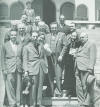
On October 5, 1946, the juridical standing of the hospital was established. The
notary Girolamo Caggianelli of Foggia created a share holding company named “Societa’
Anonima Casa Sollievo della Sofferenza” with the purpose of building and
managing a Hospital in San Giovanni Rotondo for the cure and care of the sick,
including spiritual care.[23]
[24]
The six underwriters were dr. Sanguinetti, eng. Eleanora Figna (graduated in
engineering from the Polytechnic Institute of Turin (Piergiorgio Frassati was
her classmate), dr. Kisvarday, rev. Giuseppe Orlando, Pasquale De Meis, and dr.
Panicali. Each of them renounced any personal profit.[25]
The project was joined later by dr. Sanvico, Angela Serritelli, count Telfner,
Mario Cacciaglia, marquis
Sacchetti,
marquis Patrizi, att. Ungaro, att. Pennelli and others.
Bernardo Patrizi was a scion of the Lee family of Virginia, through his great -
grandmother, sister of the general Robert Lee.[26]
[23] Pad09, 186-191
[24] Mul09, 188
[25] Pre00, 158
[26] Ruf91, 282 |
 Count Telfner was cousin of Irving
Berlin. Iriving Berlin visited the Telfners when he was performing in July 1943
for the American troups in Foggia. Berlin, who was Jewish, visited with Padre
Pio who gave him a rosary for his wife, who was Catholic.[27] Count Telfner was cousin of Irving
Berlin. Iriving Berlin visited the Telfners when he was performing in July 1943
for the American troups in Foggia. Berlin, who was Jewish, visited with Padre
Pio who gave him a rosary for his wife, who was Catholic.[27]In the picture count Telfner at the home of Mary Pyle, visiting with Padre Pio's father and two nieces. [27] Ruf91, 257 |
|
 
On October 5, 1946 Padre Pio was assisting his dying father Grazio at the home
of Mary Pyle.
When Dr. Sanguinetti and Eng. Figna presented him the documents defining the
legal corporation Padre Pio gave his blessing: “May it be as God has wanted. May
it grow. May it heal bodies and sanctify souls.” And for the collaborators: “May
the good Lord reward them a hundred times over in this life, and with eternal
life in the next.”[28] Padre Pio caring for his dying father.
|
|
|
Donations of the land |
|

Three days after Casa Sollievo was incorporated, Maria Basilio, a wealthy lady
from Turin, donated the land adjacent to the friary were the hospital would be
located. It was a tract of public land sold by the city council to Maria, for a
charitable institution to be built. The land was a steep slope of the mountain
near the convent.
[29]
[29] Leo86, 29
|
|
|
Maria Basilio was a businesswoman from the Venchi family in Turin. She met Padre
Pio on December 5, 1918. Padre Pio told her: ”Welcome Maria; I have been waiting
for you.” On May 9, 1923 she
donated a gold calyx to Padre Pio. She moved to San Giovanni Rotondo and, as
spiritual daughter, dedicated to the cause of Padre Pio her life, thoughts,
heart, and possessions. In December 1935
she officially purchased from Filippo Lombardi the land near the friary
were the hospital would be built. |
|
  The following day Angela Serritelli donated a parcel of land that she owned
adjoining the Basilio donation.[30] The following day Angela Serritelli donated a parcel of land that she owned
adjoining the Basilio donation.[30] |
|
| Angela Serritelli was from San Giovanni Rotondo. She was an elementary school teacher. She met Padre Pio on January 23, 1917. In that year she became Franciscan tertiary and dedicated herself to the cause of Padre Pio. She died on May 30, 1976. She left a manuscript, later published in Foggia “Notizie su Padre Pio”, where she reported personal experiences, prodigies, and facts related to Padre Pio. |
|
The
construction begins |
|
| 1946 |

 On May 16, 1946 Padre Pio blessed the cornerstone,
and on May 19 the first shovel of dirt was turned.
On May 16, 1946 Padre Pio blessed the cornerstone,
and on May 19 the first shovel of dirt was turned. |
| 1947 |
On May 1947 the first administrative council of the new society was formed.
Sacchetti, president; Sanvico, vice president; Sanguinetti, delegate; Kisvarday,
treasurer.[31]
Padre Pio was pressing for the work to start.
|
|
The overall supervision was given to rev. Giuseppe Orlando.
Orlando reported that in every meeting Padre Pio would nudge him in the side
with his elbow, so much that he avoided sitting near him. Padre Pio was pressing him
to start work, and Orlando replied: “How can we start work without a plan,
without a blueprint, without a contractor?”[32]
|
|
 Rev.
Giuseppe Orlando was a priest in Pietrelcina, friend of Padre Pio who
called him "my younger brother". Everybody
else called him "Don Peppino the Marquis" because he had been adopted by
Marquis Ferdinando Di Girardi and Marchionness Maria Emmanuela
Caracciolo. He inherited their castle in Pago Veiano. Padre Pio wrote
nineteen letters to Don Peppino the Marquis, between 1921-1924. Don
Peppino helped Padre Pio anyway he could. He moved to San Giovanni
Rotondo when Padre Pio asked him to join the effort for building Casa
Sollievo. He was put in charge of the overall supervision. The first
daunting task was to level off the side of the mountain were the
hospital was to be built. He had no experience whatsoever. The result
was extraordinary. Picture: Orlando standing behind
Padre Pio. Rev.
Giuseppe Orlando was a priest in Pietrelcina, friend of Padre Pio who
called him "my younger brother". Everybody
else called him "Don Peppino the Marquis" because he had been adopted by
Marquis Ferdinando Di Girardi and Marchionness Maria Emmanuela
Caracciolo. He inherited their castle in Pago Veiano. Padre Pio wrote
nineteen letters to Don Peppino the Marquis, between 1921-1924. Don
Peppino helped Padre Pio anyway he could. He moved to San Giovanni
Rotondo when Padre Pio asked him to join the effort for building Casa
Sollievo. He was put in charge of the overall supervision. The first
daunting task was to level off the side of the mountain were the
hospital was to be built. He had no experience whatsoever. The result
was extraordinary. Picture: Orlando standing behind
Padre Pio. |
|
|
Consequently sketches were requested from architects and engineers.
A sketch admired by most was the one by a certain “Civil Engineer Candeloro”. The man was
summoned, but was nowhere to be found. They soon realized the sketch had been
presented by Angelo Lupi under false name. |
|

Angelo Lupi from Castel Frentano, province of Chieti, in Abruzzi region, was not
an engineer and not an architect. He had some schooling but no degree in
anything. He had
worked in various places in costruction, learning on the field.
Angelo Lupi was an eccentric temperamental genius. Padre Pio decided that he was
the right man for the job. Lupi was put in charge of the project and
construction of Casa Sollievo.[33]
[33] Gia12, 319 |
|
 Dr.
Kisvarday took care of the finances. Dr.
Kisvarday took care of the finances.
The balance sheet was made public, and showed that the money had been well
spent, with great savings over average similar costs.[38]
All sorts of means were used to collect funds, including lotteries, raffles,
bazaars. In every shop and store there was box for donations,[39]
|
|
|
Padre Pio was firmly against bank loans. He wanted the project financed only
with donations.[40]
[40] Chi99, 259-60 |
|
Barbara Ward |
|
| 1947 |
Barbara Ward was born in Heworth, Yorkshire, England. She went to a convent
school, then studied at the Sorbonne and graduated from Oxford. She was a
fervent Catholic involved in numerous catholic organizations.
As a journalist for “The Economist” she went to Rome in the fall of 1947 to
write a report on the postwar reconstruction. In Rome she was guest of marquis
Bernardo Patrizi.
Patrizi was one of the early supporters of Casa Sollievo. Barbara Ward expressed
the desire to meet Padre Pio, and Patrizi offered to accompany her. In San
Giovanni Rotondo they were guests of the Sanguinettis.[41]
|
 When Barbara Ward arrived in San Giovanni Rotondo with Patrizi she first
visited the work site of the hospital, asking many questions especially
about costs and financing. She met Padre Pio and asked for the
conversion to Catholicism or her fiancée Robert Jackson. Padre Pio said:
“If God wants, he will convert.” “When will that be?” “If God wants,
right now.”[42]
When Barbara Ward arrived in San Giovanni Rotondo with Patrizi she first
visited the work site of the hospital, asking many questions especially
about costs and financing. She met Padre Pio and asked for the
conversion to Catholicism or her fiancée Robert Jackson. Padre Pio said:
“If God wants, he will convert.” “When will that be?” “If God wants,
right now.”[42]
Back in London she found out that on the very day
and hour that she was visiting with Padre Pio, Commander Robert Jackson
has converted to Catholicism.
He had been passing by a Jesuit church on that particular
day and time, and felt inspired to go in and visit the rectory were he asked to
be accepted in the Catholic faith. Barbara talked to Robert at length,
describing the construction of the hospital.
[42] Pre00. 60
[43] Pre00, 160-1 |
|

  Barbara Ward at the construction site.
Barbara Ward at the construction site.
 |
|
|
Spectacular funding |
|
| 1948 |
Robert got into action, and on June 21 1948 the U.S. Congress approved the
proposed funding, and UNRRA notified Alcide De Gasperi, prime minister of Italy,
that the hospital of Padre Pio had been assigned 400 million lire. That was an
immense amount of money at the time.[44]
The Italian government didn’t know anything about the hospital and asked
information to the Prefect of Foggia, the province where San Giovanni Rotondo
was located. The prefect was not aware of the construction and delegated the
provincial medical director to investigate. The medical director went to the
construction site, and had to report back that a new hospital was being built
without any documentation of approval. However he offered to help Padre Pio in
gathering the necessary documentation for approval from the department of health
in Rome. It took six months of bureaucratic battles, but at the end the project was approved. However the Project received only 250 of the 400 million lire allocated. The difference was kept by the Italian government for other projects. Robert Jackson went to San Giovanni Rotondo, and meeting Padre Pio told him: “I know that you need funds. I will do what I can to help you get them.”
The grant would be in memory of Fiorello La Guardia.[45]
[44] Reg05, 214-21
[45] Reg05, 218
|
| The construction continues at steady pace | |
| 1948 |

Padre Dominic Meyer wrote to his American relatives: “Angelo Lupi is architect,
contractor, superintendent and a lot of other things for the new hospital.
Through his genius, all manner of necessary equipment and supplies are being
made here. This saves a lot of money and gives work to the poor people here.”[36]
In the pictures taken in May 1948, Padre Pio going to the site of the lime-kiln and blessing it.
[34] Pre00, 159
|
| 1949 |



 In September1949 the bulletin Casa Sollievo della Sofferenza was started
in order to provide the friends of the institution with first hand
information on the progress. It was located in a wooden hut built with
wartime leftovers. Soon it had to expand the number of pager and
increase the amount of copies, and moved to more acceptable quarters.
The last picture shows Padre Pio and dr. Sanguinetti goin over a
bulletin before publication.
In September1949 the bulletin Casa Sollievo della Sofferenza was started
in order to provide the friends of the institution with first hand
information on the progress. It was located in a wooden hut built with
wartime leftovers. Soon it had to expand the number of pager and
increase the amount of copies, and moved to more acceptable quarters.
The last picture shows Padre Pio and dr. Sanguinetti goin over a
bulletin before publication. |
| 1949 |

 On September 2, 1949, the construction had reached
the first roof. Padre Pio did the blessing. There were Italian and
American authorities. The administrator delegate poured holy water on
the first beam of the roof.
On September 2, 1949, the construction had reached
the first roof. Padre Pio did the blessing. There were Italian and
American authorities. The administrator delegate poured holy water on
the first beam of the roof. |
| 1950 |
    For about a year the construction was named “Clinica Fiorello La Guardia, “
afterwards it was
resumed the
original name of “Casa Sollievo della Sofferenza.” For about a year the construction was named “Clinica Fiorello La Guardia, “
afterwards it was
resumed the
original name of “Casa Sollievo della Sofferenza.”Fiorello La Guardia former mayor of New York City, was general director of UNRRA in 1946. His father had emigrated to the USA from Cerignola, in the province of Foggia, Italy. He had recently died of pancreatica cancer. |
 
 Angelo Lupi (clear pants) with Padre Pio at the construction site, and
showing him a painting of the Holy Family that he made for the church in
Pietrelcina.
Angelo Lupi (clear pants) with Padre Pio at the construction site, and
showing him a painting of the Holy Family that he made for the church in
Pietrelcina. |
|

 On June 21, 1950 Dr Sanguinetti on a scaffolding simbolicaly
traces the letter C on top of the front of Casa Sollievo.
On June 21, 1950 Dr Sanguinetti on a scaffolding simbolicaly
traces the letter C on top of the front of Casa Sollievo. |
|
 In the basement of Casa Sollievo a workshop was set up for the
manufacture of the artificial marble used to cover the outside and
inside walls, an to make floor tiles, doorposts, and doorsteps.
In the basement of Casa Sollievo a workshop was set up for the
manufacture of the artificial marble used to cover the outside and
inside walls, an to make floor tiles, doorposts, and doorsteps.
|
|
 There were also female workers. They laid down the mosaic floorings.
There were also female workers. They laid down the mosaic floorings.
|
|
 Payday for the workers at Casa
Sollievo
Payday for the workers at Casa
Sollievo
 Lunch brake
Lunch brake
 Padre Pio testing the food of the workers.
Padre Pio testing the food of the workers. |
|

  Padre Pio visited frequently the construction site getting rides on cars
of friends .
Padre Pio visited frequently the construction site getting rides on cars
of friends . |
|
 On July 26, 1954 the Outpatient Clinic was opened. In the picture
Padre Pio blessing the analysis lab.
On July 26, 1954 the Outpatient Clinic was opened. In the picture
Padre Pio blessing the analysis lab. |
|



 Padre Pio on the roof of Casa Sollievo, admiring a stained window in the
chapel, with dr. Sanvico and others.
Padre Pio on the roof of Casa Sollievo, admiring a stained window in the
chapel, with dr. Sanvico and others. |
|
|
While the construction was going on, Lupi was charged by and engineer in Foggia
of “abusive exercise of the profession of an architect.”
Padre Pio told Angelo: “Don’t worry my
son. That person has received his degree from men. You have received your from
God.” He was called into court for presenting himself as an engineer, but
it was impossible to accuse him of not knowing how to do that which he had
already done so beautifully. The matter was dropped.[37]
|
|

 


 |
|
Stained window Madonna |
|
| 1950 |
Barbara, with her fiancée Robert visited again the construction in the fall of
1950. They were very pleased with the way the money from UNRRA had been used.
When Barbara Wards entered the chapel of the hospital she was pleasantly
surprised that the face of Mary in the stained window on the altar resembled her
own.[46]
Angelo Lupi had had the idea, since everybody considered Barbara Word the
godmother of the hospital.[47]
[46] Pre00, 162
[47] Ruf91, 284 |
|
Barbara Ward wrote of Padre Pio: “He had downright common sense and intensely
practical attitude towards life. Nine tenths of the people who came to Padre Pio
were in unrelieved poverty. Poverty was the root of so many neglected diseases,
lifelong ill health, crippling, blindness, infirmities and miseries. That entire
tragic load had to be borne by him day after day, from the moment he entered the
church at dawn until the last penitents went on their way. Padre Pio was the
last man in the world to let his friends forget the Our Lord not only preached
to souls but also healed bodies and promised Heaven to those who feed the hungry
and clothe the naked. If there was to be medical care, the hospital needed to be
in San Giovanni Rotondo. This was the common sense of Padre Pio and he expected
from his friends common sense practical support for his charitable project.”. When the building was completed, other architects, the ones who actually had degree, called the work of Angelo Lupi a genuine miracle
|
|
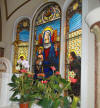 


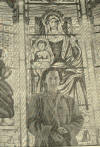 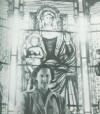

The stained window in the chapel of Casa Sollievo. Barbara Ward standing in front of it. |
|
Grand
opening |
|
| 1956 |
The grand opening of Casa Sollievo della Sofferenza took place on May 5, 1956.
Pope Pius XII sent a congratulatory telegram, praising “the work of a high
evangelic feeling of love”. Cardinal Lercaro and Padre Benigno, the general
superior of the Capuchin order were present, among many thousand people,
including Enrico Medi, Beniamino Gigli, and the widow of Guglielmo Marconi.[49] Padre Pio read a memorable speech.[50] [51]
[49] Pre00, 163
[50] Gau74, 172-9
[51] Pre00, 163-4
|
 

 Cardinal Lercaro gave a stirring address.
Cardinal Lercaro gave a stirring address. 



 Padre Pio made a memorable speech.
Padre Pio made a memorable speech.
 Ribbon cutting: Cardinal Lercaro and Padre Pio.
Ribbon cutting: Cardinal Lercaro and Padre Pio. |
|

  Among the present were Cesare Merzagora, president
of the Italian Senate, tenor Beniamino Gigli and the major of San
Giovanni Rotondo.
Among the present were Cesare Merzagora, president
of the Italian Senate, tenor Beniamino Gigli and the major of San
Giovanni Rotondo.
 At the end of the memorable opening day Padre Pio
had a group picture with some of the people that had made all possible,
including Dr. and Mrs. Sanguinetti, Angelo Lupi with his wife and
children, clerks, technicians, and labourers.
At the end of the memorable opening day Padre Pio
had a group picture with some of the people that had made all possible,
including Dr. and Mrs. Sanguinetti, Angelo Lupi with his wife and
children, clerks, technicians, and labourers. |
|
| The New York Times on July 29, 1956 described Casa Sollievo as "One of the most beautiful as well as one of the most modern and fully equipped hospitals in the world. It even has an helicopter landing place on the roof. Its different shades of lovely green marble, it's fine tile work, its bright pleasant rooms ... its ultra-modern operating rooms, laboratories, and kitchen, its little chapel with its precious stained-glass windows, its staff of top-flight surgeons and specialists - every detail - make it as beautiful and up-to-date a place to take away suffering as one can hope to find." | |


 
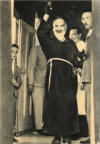 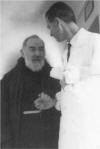
 Padre Pio visiting with patients. nuns, nurses and doctors.
Padre Pio visiting with patients. nuns, nurses and doctors. |
|

 Padre
Pio with workers in the emergency room, with Angelo Lupi and engineer
Nora Figna. Padre
Pio with workers in the emergency room, with Angelo Lupi and engineer
Nora Figna. |
|
 On the feast of Corpus Christi Padre Pio took the Blessed Sacrament in
every room of every floor.
On the feast of Corpus Christi Padre Pio took the Blessed Sacrament in
every room of every floor.
 A fatima celebration on the womens floor.
A fatima celebration on the womens floor. |
|

 At
Christmas Padre Pio visited the nativity scene prepared by the employees
of Casa Sollievo, and assisted at a children's religious play. At
Christmas Padre Pio visited the nativity scene prepared by the employees
of Casa Sollievo, and assisted at a children's religious play. |
|
 Visiting the school for the children of the employees.
Visiting the school for the children of the employees.
 Wherever Padre Pio went outside the convent, Carabinieri were needed to
regulate the crowds.
Wherever Padre Pio went outside the convent, Carabinieri were needed to
regulate the crowds. |
|
|
The prodigy continues |
|
|
The first patient was admitted on May 10, 1954 and was assigned one of the 250
beds. In 1959 a new wing was built, increasing the capacity to 600 beds.
Padre Pio called the Casa Sollievo “The structure that will defy the centuries”.
When somebody told him the Casa Sollievo was too luxurious, too richly adorned
Padre Pio replied: “Too luxurious? If I could have done so, I would have made it
all of gold, because the sick are Jesus, and what is done for the Lord is always
too little.”[52]
Dr. Pavone reported: “Padre Pio continually told the nuns, the nurses, and the
doctors: “When you see the patient, look at Jesus Christ. In every sick person,
see Jesus suffering. Do everything out of love for Jesus Christ. Do it with
love. Bring love.””[53]
[52] Pre00, 162
[53] Sch87, 35 |
|
| 1957 |


 On May 5, 1957, the first anniversary of Casa Sollievo, Padre Pio
celebrated Mass outside and read a speech.
On May 5, 1957, the first anniversary of Casa Sollievo, Padre Pio
celebrated Mass outside and read a speech. |
| 1958 |
 On
May 5, 1958, the second anniversary of the grand opening, Padre Pio
celebrated an open air Mass on the altar placed between the pillars of
the entrance. The same day he pulled a lever and a mine exploded on the
mountain. That was the simbolic starte of a major expansion of Casa
Sollievo. On
May 5, 1958, the second anniversary of the grand opening, Padre Pio
celebrated an open air Mass on the altar placed between the pillars of
the entrance. The same day he pulled a lever and a mine exploded on the
mountain. That was the simbolic starte of a major expansion of Casa
Sollievo. |
 On July 16, 1968 the cornerstone of the new wing of Casa Sollievo was
put in place. Padre Pio was present at the ceremony.
On July 16, 1968 the cornerstone of the new wing of Casa Sollievo was
put in place. Padre Pio was present at the ceremony. |
|
| 1964 |

 On October 24, 1964 Padre Pio, at a Congress on Radiology, greeted
the participants and blessed the new Conference Hall and the Scientific
Library.
On October 24, 1964 Padre Pio, at a Congress on Radiology, greeted
the participants and blessed the new Conference Hall and the Scientific
Library. |
| 1966 |
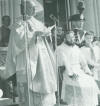 
 On May 5, 1966, the 10th anniversary
of Casa Sollievo Cardinal Lercaro celebrated the open air Mass and made
a speech. PadrePio assisted to it with the friars and the pilgrims.
After the celebration Padre Pio left, surrounded by the crowds.
On May 5, 1966, the 10th anniversary
of Casa Sollievo Cardinal Lercaro celebrated the open air Mass and made
a speech. PadrePio assisted to it with the friars and the pilgrims.
After the celebration Padre Pio left, surrounded by the crowds. |




  More images of the Congress on Radiology
More images of the Congress on Radiology |
|
| Padre Pio died on September 23, 1968. |
|
Casa Sollievo today in 2013 |
|
| 2013 |

 |
|
Currently in 2013 the Casa Sollievo is property of the Holy See as disposed by Padre Pio in his wills on October 4, 1960 and May 11, 1964. It is administered through the Secretary of State. The current president of the Administrative Council, appointed by the Secretary of State Card. Tarcisio Bertone is Mons. Michele Castoro, Archbishop of Manfredonia, Vieste, and San Giovanni Rotondo.
Casa Sollievo has 1000 beds, 26 departments, 50 clinical specialties, 3000
employees.
The large Poliambulatory John Paul II is close to the hospital.
There are dialysis centers in the surrounding towns of Manfredonia, Rodi
Garganico and Vieste.
In Rome there is the “Casa Sollievo
della Sofferenza – Mendel.” It is a structure for scientific research founded by
dr. Luigi Gedda in 1953, and donated in 1998.
54] Per02, 539
[55] Fer08, 373
[56] Ger02, 71
|
|
|
The hospital owns two large farms in the area, which provide wine, olive oil, grain, meat and other products for its daily needs.
One of the farms is “Masseria Calderoso”, located in National Park of Gargano,
where on 70 hectares of olive groves, extra virgin biological olive oil is
produced.
The other farm is “Azienda agro-zootecnica Posta La Via”, cattle and dairy farm,
on 200 hectares, were 700 bovine
produce milk, cheeses, mozzarella, ricotta, caciocavallo, caciotta, butter,
yogurt, pudding, ice cream, and meats. They are fed biological forage grown on
the farm. Vegetables are also grown.
|
|
|
Casa Sollievo Opera Padre Pio administers several other social activities near
the hospital:
The “Casa Padre Pio” for elderly people, has 56 beds as retirement home, 36 beds
as nursing home, and 114 beds as long term hotel like setting.
The “Centro Accoglienza S. Maria delle Grazie” has 207 beds and a convention
center.
The “Casa San Francesco” has 25 beds for relatives of hospitalized people, and
for people needing outpatient care for more than one day.
The “Cenacolo Santa Chiara” has 70 beds for “spiritual exercises”. |
|
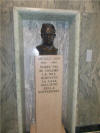


 Busts
of Angelo Lupi and dr. Sanguinetti, Busts
of Angelo Lupi and dr. Sanguinetti,
Guglielmo Sanguinetti was not at the grand opening. He had died on September 9, 1954 of a heart attack. Mario Sanvico ha died of cancer seven month after, in April 1955. Angelo Lupi had been let go. |
|



 The new chapel inside Casa Sollievo
The new chapel inside Casa Sollievo |
|


















 
 Museum of Casa Sollievo
Museum of Casa Sollievo |
|
|
If one thinks just for a moment of the immensity and complexity of the task of
setting up such a grandiose hospital in the middle of nowhere, no amount of
thought and planning, of blood, sweat and tears, could be up to the task, of
creating a powerhouse of love for the neighbor, and alleviation of human
suffering, as Padre Pio did.[58]
|
|
|
Bravo Padre Pio! |